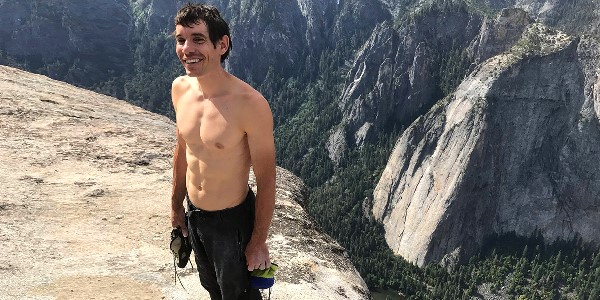Free solo: to scale a mountain without ropes, harness, or any other apparatus, and in which the climber finds traction through the cracks within the mountain wall.
Perhaps it goes without saying that the sport has a high fatality rate.
Given the risks involved, this documentary about free soloing, which makes its international premiere today at the Toronto International Film Festival, is steadily suspenseful to the point of being sometimes hard to watch. That is perhaps the film’s greatest feat, given that it features a most undemonstrative subject to be profiled, Alex Honnold.
The author of the 2015 book, Alone on the Wall, Honnold has more than a thousand climbs under his belt and has previously climbed, free solo–style, the Moonlight Buttress in Zion National Park in 2008. That same year, he also summited Yosemite National Park’s Half Dome. Now he has set his sights on becoming the first person to free solo up the park’s El Capitan, a vertical, 3,000-foot high granite, flat-topped cliff.
Honnold lives in a van, and he makes it clear during his one-on-ones with filmmakers E. Chai Vasarhelyi and Jimmy Chin (Meru) that he, “will always choose climbing over a lady.” During his book tour, though, he signed a copy for a fan, Sanni McCandless, who gave him her phone number. She now has moved in with him (he reasons, “She doesn’t take much room”) as he trains for his climb up El Capitan. However, within a month he falls twice, coming away with minor injuries, which raises the obvious question of whether he is focused enough to attempt the climb. His mentor, Tommy Caldwell, the subject of the upcoming documentary The Dawn Wall, opines that a romantic relationship is not conducive to Honnold’s focus at the moment. Co-director Chin also voices his concern that the cameras and film crew are exerting too much pressure on the climber.
McCandless readily admits that Honnold has a long way to go in expressing his feelings; Honnold claims he only learned how to hug at the age of 23. At times, he comes across as being insensitive, if not callous, based on his reactions to his girlfriend’s concerns. He acknowledges that he thinks differently and even undergoes on camera an MRI brain scan. The doctor’s somewhat cryptic conclusion: he is not stimulated by what the majority of people finds intriguing.
Honnold will go on to dismiss McCandless’s concerns about his safety by saying, in a monotone, that she’ll find someone else if the worst happens to him. Yet later when he initially sets out to climb El Capitan, he has second thoughts, and within minutes of his ascent, he backs down. Co-director Chin may speak for the entire audience when he says, “It’s kind of reassuring that Spock has nerves.”
Besides fear, incredulity may be another reaction from seeing this white-knuckle film. Viewers will have to wonder how the filmmakers were able to film thousands of feet up in the air with remote cameras. During many of the ascents, Chin holds a large camera while climbing, harnessed, alongside Honnold. (Many sequences would have been impossible without the use of telescopic lenses.) Three-dimensional special effects aren’t necessary to be impressed by the scale of heights and the depth of field—or to induce vertigo. This is an amazing feat in filmmaking.
There’s more than enough here to hold viewers’ interest: the challenge of the climb, the mystery behind Honnold’s motivation, the stunning visuals, and an out-of-the-blue encounter that the climber has with a man in a pink bunny suit 980 feet up a cliff. See it and believe it.
The film opens nationally on September 21.







Beautiful I love it .. Wow